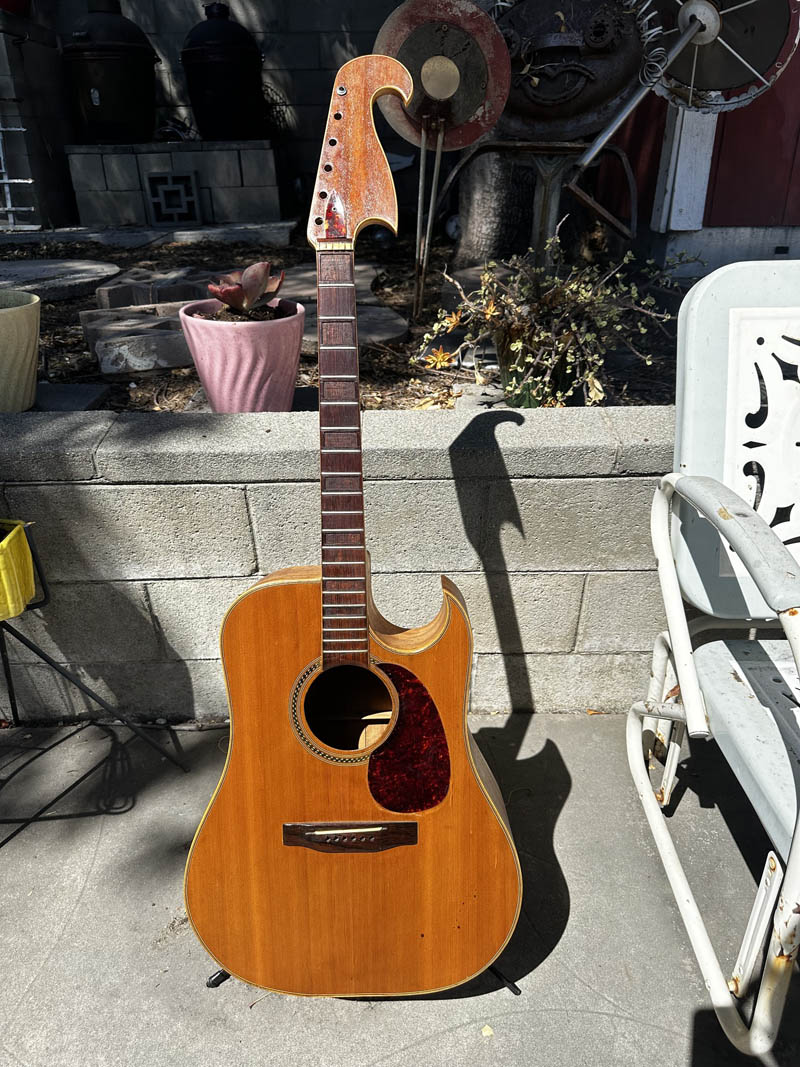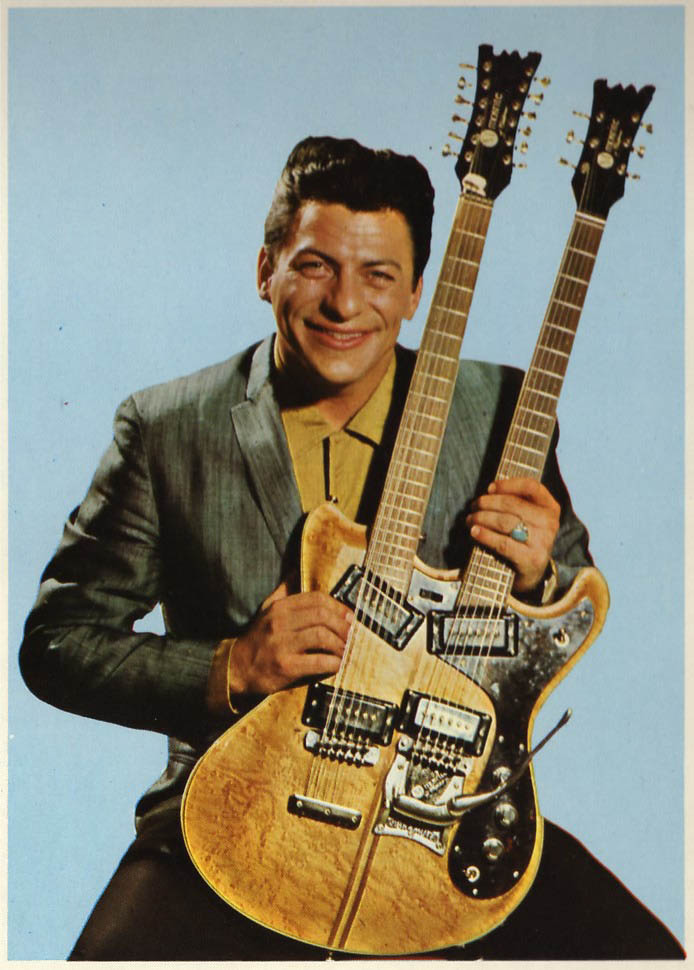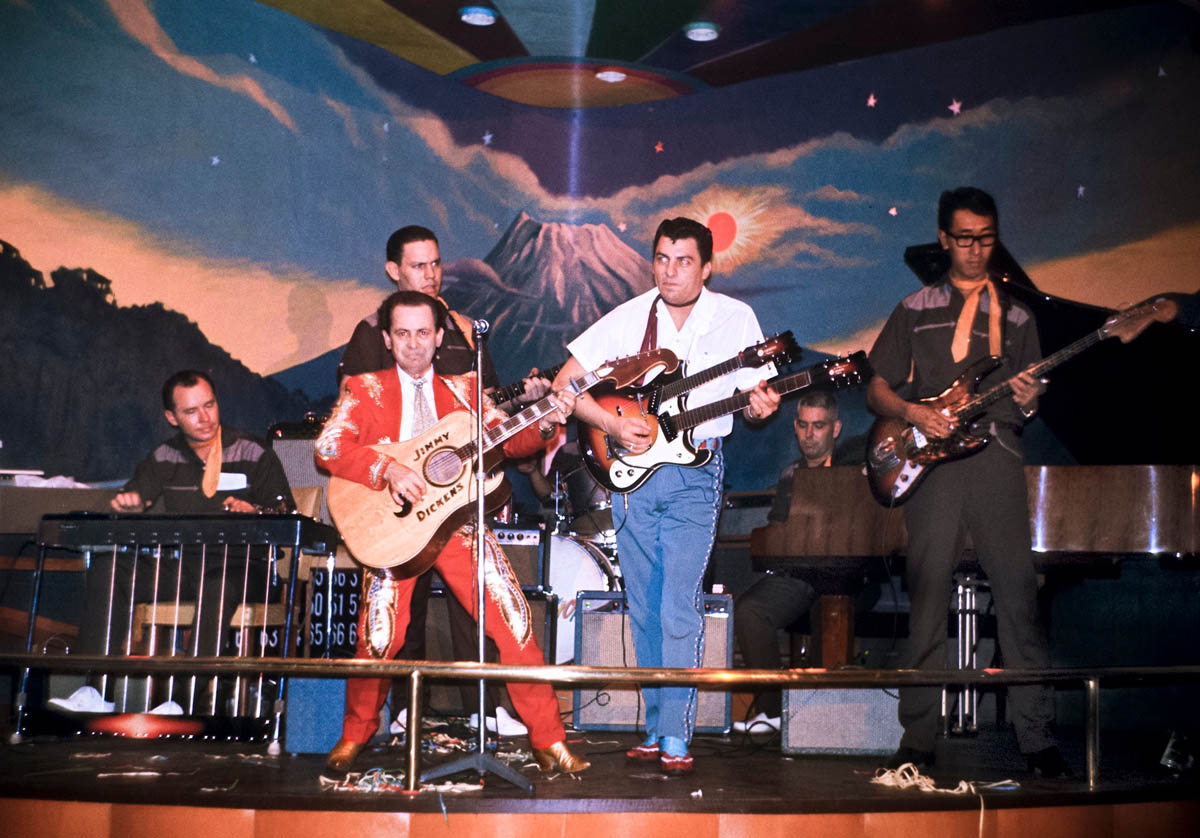Here’s your guitar rabbit hole for the day! I was going through some old CD-Rs of photos yesterday and found this great photo of “Little” Jimmy Dickens on stage in the early 1960s, with the great Gino (Gene) King on guitar. If you’re a guitar nerd, hang on and buckle your seat belt, here we go down the hole…
Jimmy can be seen playing an extremely rare, Bigsby-influenced “Farber” guitar. I’ve gone down the rabbit hole on these, and I have found evidence of at least four of these guitars being made. The Jimmy Dickens guitar was later refurbished in the 1970s and went into the Roy Acuff collection museum (it can be seen in the late-1970s book featuring the Acuff collection). Most of the Acuff collection went into the Grand Ole Opry Museum, which flooded in 2010. I’ve tried to find out if the Jimmy Dickens Farber was in storage and what happened to it, to no avail.
Bobby Adamson of the Farmer Boys briefly owned a Farber guitar in the early 1960s. He can be seen with it in one photo of the group performing live in Rosamond, California. I asked Bobby about the guitar when I went to his house, and he told me it was smashed to bits. He also revealed that Farber had a shop somewhere in a little town between Bakersfield and Fresno.

There was another Farber that turned up on eBay years ago, which went for more money than I wanted to pay. It was the same design as the others, a big Martin-size body with a sharp cutaway and a six-on-a-side headstock.

I found a Farber (pictured here) on eBay in “project” condition, I’ve had it about twenty years and never fixed it up. It’s a well-made guitar! Nice construction and materials, with an X-braced top. Beyond the six-on-a-side headstock, there isn’t much Bigsby influence, but you could tell he was trying to make a custom hillbilly machine. How he hooked up with “Little” Jimmy Dickens is a bit of a mystery, but the guy obviously made a few guitars. Does my fuzzy memory also think that I saw a Farber electric solidbody online at one point? I can’t remember now. Anybody with more info on the mysterious Farber, I’d love to know!
Now, let’s take a look at Jimmy’s guitarist, Gino King. I was pals with Gino, he was from La Crosse, Wisconsin, and he was a real character. I can’t repeat any of the stories he told me, but I’ll tell you in person if you want to know. His most innocent story involved taking LSD with a hooker in Oklahoma and waking up naked on a ledge outside his hotel room, ten stories up, with the hooker and all of his clothes and money gone. Gino was a crazy guy.
Gino had some nice guitars. He showed me a photo of him with a beautiful Gibson Super 400 with P-90s that he played in the 1950s. He had a really nice mildly customized Gretsch 6120 with some extra knobs. When he started playing with “Little” Jimmy Dickens in the early 1960s, he met Semie Moseley of Mosrite fame. Jimmy Dickens had known Semie for a while; Semie had customized his Gibson J-200 with a Mosrite neck and sunburst paint job in the 1950s. This first color slide shows Gino playing a 1963–64 era Mosrite Joe Maphis double neck, the only photo I have of him playing this particular instrument. He didn’t own this one for very long.
In 1965, “Little” Jimmy ordered a custom Mosrite doubleneck for Gino. It was over the top: twelve-string neck on the top, six-string on the bottom, bird’s-eye maple carved top with a walnut racing stripe, and a crazy purple-to-cream sunburst on the back of the guitar. This would become Gino’s main instrument for over ten years, and a big part of the “Little” Jimmy Dickens show. I’ve even found a photo of a young, clean-shaven Willie Nelson holding the instrument.


When I met Gino, he held a grudge against country singer Leroy Van Dyke. He said that after he quit playing with Jimmy Dickens around 1975, he got a job with Leroy Van Dyke (famous for “The Auctioneer” and “Walk On By”). Leroy was jealous of all the attention that the Mosrite doubleneck received from the audiences. While they were on tour in Colorado, Leroy insisted that Gino sell his prized guitar and buy something less conspicuous. Gino was furious, and he said he wished he still had the guitar, because he loved it so much.
After my initial visit with Gino in La Crosse, a year or two later a Mosrite doubleneck popped up on eBay. It was located in Colorado, exactly where Gino said that Leroy Van Dyke had forced him to sell the instrument. There was no mistaking it: bird’s-eye maple top with the walnut racing stripe; the purple-to-cream sunburst on the back; the extra features; and even the special fiberboard road case that Shot Jackson of Sho-Bud fame had made for Gino to take the guitar on the road. There was no doubt—this was Gino’s guitar! The price was not insane and I had just got a check for something, so I bought it.
I called Gino and told him I’d like to bring the guitar back up to him. He told me he wasn’t in great health but he’d like to see it. I was driving my van from California to Wisconsin to play one of the great “Green Bay Rockin’ 50s Fest” weekends, so I loaded the Mosrite in the van and headed up to the great wild North.
I talked to Dave Rogers from Dave’s Guitar Shop in La Crosse, and we arranged for the visit and the photo shoot to happen at his guitar store. When I met Gino that day, about two years after our initial visit, I was really sad to see how bad his health had become. He managed to get in and out of his car with crutches, but he needed a wheelchair, and he just looked like he was at the end of his journey. After seeing Gino’s condition, I arranged with Dave to leave the guitar at Dave’s Guitar Shop on display in a special case where Gino could come visit it and play it anytime, along with copies of the albums Gino made in the 1960s. It was a nice little shrine to a local hero.
Gino was thrilled to see the guitar again after so many years, and as he played it, sitting in his wheelchair in the store, he had tears running down his face. Damn, that was one of the best things I think I ever did, reuniting Gino with that guitar. It made Gino happy, and it sure made me happy. I’m just glad I made it there in time to reunite him with the guitar. Gino died about six weeks later, and Dave Rogers returned the guitar to me (Dave is a solid dude, I highly recommend that place if you’re looking to buy a guitar).
So many of the old-timers are dead now. All we have left are photos of the wild days of country music, and the few instruments that remain. Some mysteries get solved, like Gino King’s doubleneck coming up for sale just a few miles away from where he sold it fifty years earlier. Some mysteries remain, like the custom-made Bigsby-influenced Farber guitars of the San Joaquin Valley. I sure am glad that I got to meet so many of these people while they were still around. And I’m still diving down the rabbit hole, trying to solve these mysteries.
